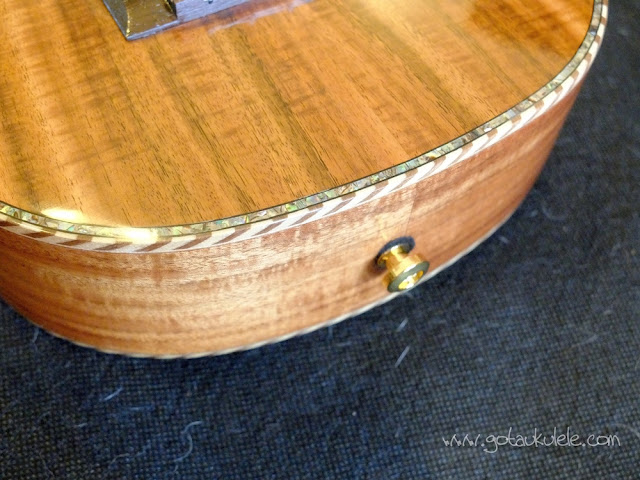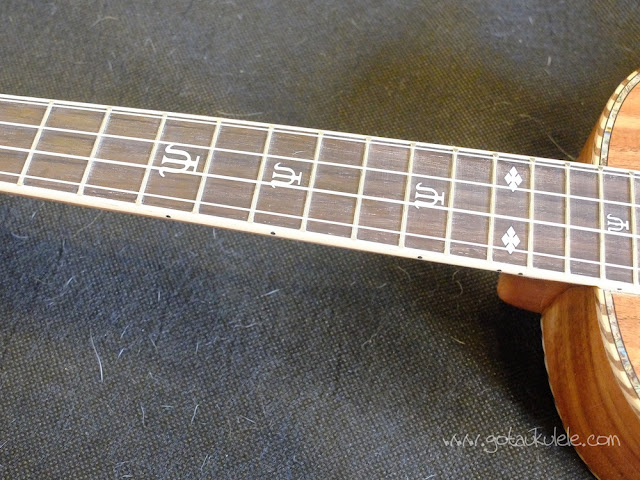Catching up with the ukulele review schedule and a new brand for me that I have had on loan for some time now from Southern Ukulele Store. PSI Ukuleles and their PSI-S-LEO II Tenor uke from their Standard Series range.
The first thing that grabs you about this instrument is bling bling BLING! Regular readers will know that I prefer plainer instruments, but it is worth pointing out that I don't down score any instruments I review just because they have bling. I will down score if there are issues with how it is applied, but let's carry on.
So yes, a glossy glitzy instrument all round. It's made of solid Acacia in the far east and finished in gloss.
On the top that acacia has a really nice stripe to it that I think looks wonderful and the two piece sides have the same. Would have been nice for their grain to run parallel to the ukulele but they look well made.
On to the back though and that stripe has more curl to it and some really nice flame under the gloss. Would have been nice to see that on the back but I suppose we can't have everything..
That gloss finish is very nicely done, with no gaps, flaws or pooling of the finish that I could spot.
Back to the top and the bling screams out at you. Firstly we have a mother of pearl / abalone ring around the sound hole which is nicely applied. But my gripe comes with the edge binding. The Leo II uses wooden rope inlays in brown / white / brown around the edges which I think looks great, but then it is topped off with an extra inlay of abalone next to it. I think it's over the top and unnecessary. To see what I mean, the back and sides are joined with just the rope inlay and I think it looks just fine like that. Adding in the abalone seems to me to be overkill and almost as if they went through the parts bin at the factory and threw both on.
The bridge is a tie bar style, screwed down with an uncompensated plastic saddle. The bridge mounting has been glossed, something I have seen on a couple of other ukuleles and not something I think looks that great.
Looking inside the sound hole and we have a wooden makers label with the PSI logo in pyrographic inlay, rather like those on Snail instruments.
But the LEO has another sound hole in the form of a personal side port cut in an oval on the side of the instrument. I like these and you don't see many of them in the uke world. Basically as well as projecting sound out front they project sound up to the players ear. A nice touch.
A side hole like this also allows for a closer inspection to the inside of the instrument and the first thing I noticed was notched edge kerfing on the joints and a fan bracing pattern on the lower half of the top. Unlike the more common simple two parallel braces to strengthen the top, this employs several braces laid out in a fan pattern. It's a technique from classical guitar design and interesting to see here.
The downside to a side hole is that it also allows you to see all the parts that are usually hidden. Unfortunately things are pretty messy inside this instrument. Stains on the wood, glue seepage, wood shavings and a ton of dust all on show to the owner. Does this affect the sound? Probably not, but it does give an indication as to the care than went into the build. Really very messy indeed.
Moving on, we have a hard wood neck with a joint in the heel and at the headstock. It's got a nice chunky C shaped profiled which I found very comfortable. The width at the nut though is fairly standard far eastern style and I would have preferred it a touch wider.
The fingerboard is rosewood and edge bound in cream which is the sort of bling I can live with. We have 14 nickel silver frets to the body and 19 in total and all are dressed really well with no sharp edges. The rosewood though shows some marks that look like glue spots and has also taken on the polish applied to the instrument in the grain giving it a speckled look.
More bling in the position markers which use an inlaid PSI logo at the 5th, 7th and 10th, then a different double marker at the 12th, before reverting to the PSI logo at the 15th and 17th. I would have preferred dots, or at least that the PSI logo was used throughout. Incidentally we have inlays in here from white mother of pearl, so yet another choice of bling from the parts bin. Thankfully we have position markers in the same places on the side of the neck with small dots.
Past the plastic nut we have a slotted headstock that I really like. It is let down for me by the rope and abalone edging once again, but the shape is very nice. The PSI logo is inlaid in white mother of pearl.
Tuning is provided by gold rear facing geared tuners which both look wonderful and work just fine.
The package is completed with Aquila Super Nylguts, gold strap buttons on the butt and neck heel, and comes in at £280 RRP in the UK which is a pretty good deal for a tenor of this specification.
To hold it isn't overly heavy and feels nicely balanced in the hands. I love the feel of the neck in the hands and it just kind of feels 'right' to hold and play. Set up was perfectly acceptable for me at both the nut and the saddle.
Sound wise, that side port does it's job very well and the projection straight up the ear is noticeable and welcomed. I say welcomed, because it isn't the loudest instrument I have every played.
Loudness is of course subjective and tone is also important, but this just didn't seem to project enough for my liking even if I strummed it hard. Don't get me wrong, the tone is good, and very bell like. In fact a bit too bright for my tastes, but certainly very clear across the strings. More delicate than punchy and I prefer punchy.
Some will love it, and it makes for a very nice 'players' ukulele for those who play alone for personal pleasure. Played in a jam or club scenario though I think I would find it slightly lacking.
In short an instrument of contradictions for me. Well made, but a little messy under the hood. Looks great, but with a confusing choice of decoration. Nice bell like tones, but lacking projection. So it left me with mixed views. The price is right through, and overall it's not a bad instrument by any means.
http://www.psiukulele.com
Be sure to check out my other ukulele reviews here!
UKULELE PROS
Looks of the woodGeneral build
Side port
Headstock
UKULELE CONS
Untidy insideLacking volume
Confused decoration
UKULELE SCORES
Looks - 8Fit and Finish - 7.5
Sound - 8
Value For Money - 9
OVERALL UKUELE SCORE - 8.1 out of 10
To understand my review scoring and see this result in context - visit my review page at
UKULELE VIDEO REVIEW
© Barry Maz












From afar it looks terrific although I agree with you. The closer you get the more OTT it looks.
ReplyDeleteI also agree with your review of this instrument. I think I might like it for the same reasons you do, and might find it a bit underwhelming in the same areas you mention. For instance, I own a few ukuleles that look absolutely stunning, but don't sound nearly as pleasing as others that are much more plain looking. Bottom line for me (and I gather for you as well) sound is everything and, generally speaking, punch trumps delicate every time. To conclude, many years ago I owned a Martin 5-K soprano (before they became so expensive) and later owned a far less flashy Martin # 3 mahogany soprano. To my surprise, I preferred the sound of the #3 and eventually gave the 5-K to my son, who sold it to finance the purchase of the guitar of his dreams.
ReplyDelete